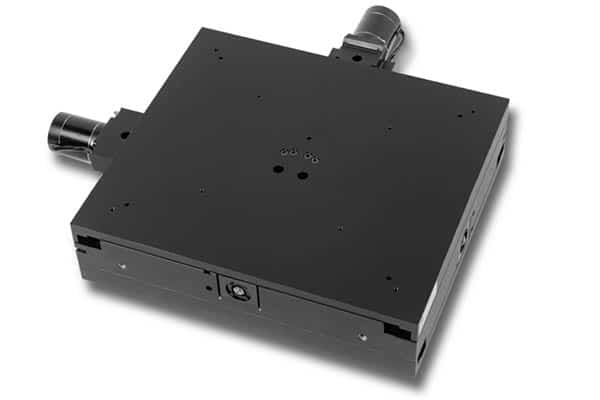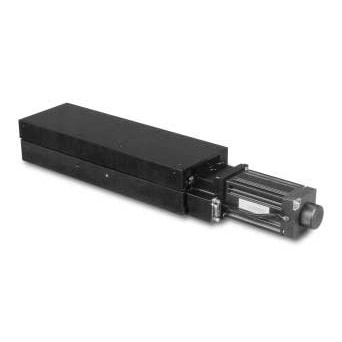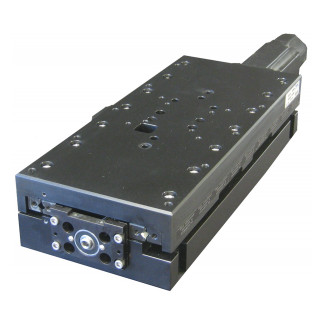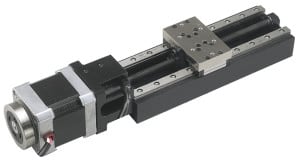Screw Driven Stages
Each of the products below can be configured to fit your unique application. Contact us to learn how we can work together to create the right motion solution for you.
The XYR™ series XY positioning stage is our most popular XY linear stage and uses a lead screw for motion. The monolithic integrated XY center makes the stage stiff and compact.
| wdt_ID | Travel | 50 - 300 mm |
|---|---|---|
| 1 | Accuracy | 15 μm |
| 2 | Repeatability | < ± 3 μm |
| 3 | Payload | 175 kg |
The LM™ series linear motion slide is a low-cost, single axis stage with crossed roller ways and stepper motor.
| wdt_ID | Travel | 50 - 300 mm |
|---|---|---|
| 1 | Accuracy | 15 μm TIR |
| 2 | Repeatability | < ± 1.5 μm |
| 3 | Payload | 175 kg |
The LMB™ series ball screw linear actuator is a high-precision, single-axis stage with crossed roller bearings.
| wdt_ID | Travel | 50 - 300 mm |
|---|---|---|
| 1 | Accuracy | 8 μm TIR |
| 2 | Repeatability | < ± 0.5 μm |
| 3 | Payload | 175 kg |
The FM™ series is a ball screw linear stage with a stiffer table and larger crossed roller bearings.
| wdt_ID | Travel | 100 - 350 mm |
|---|---|---|
| 1 | Accuracy | 5 μm TIR |
| 2 | Repeatability | < ± 1.5 μm |
| 3 | Payload | 115 kg |
The KV™ micro linear stage is a lead-screw-driven step motor stage with a miniature size.
| wdt_ID | Travel | 25 - 200 mm |
|---|---|---|
| 1 | Accuracy | 15 μm TIR |
| 2 | Repeatability | < ± 3 μm |
| 3 | Payload | 15 kg |
How Screw Driven Stages Work
Though linear motors are often used to attain linear motion, screw driven stages with a stepper motor remain a valuable tool for precision positioning. One distinct advantage that lead-screw-driven systems offer is mechanical advantage; their thread lead allows the rotary torque of the driving motor to be mechanically increased over a wide range.
Different Types of Lead Screws
Lead screws are available with leads as coarse as 50 millimeters, and as fine as 0.25 millimeters. Finer thread pitches offer increased resolution, but do so at the expense of top speed. The 2 basic types of lead screws are friction screws and ball screws.
In a friction screw, the nut operates by sliding friction along the lead screw. Low-friction materials allow the nut torque to be reduced. A radial or axial pre-load called an anti-backlash nut is also typically used and can reduce backlash to under one micron.
The other type of screw driven stage uses rolling element motion, and is called a ball screw. In a ball screw, hardened balls (typically steel) recirculate along the threads and then move through a return tube to repeat their journey over and over again. A low-cost thread generation technique is thread rolling, although this is best suited for lead screws with a slight amount of backlash.
Eliminating Ball Screw Backlash
Backlash is the unwanted movement that occurs when a screw’s threads do not fit snugly into the nut. To eliminate ball screw backlash while maintaining a low and smooth torque, thread whirling or precision thread grinding is required. Once the ball screw backlash has been eliminated from the nut, it is still necessary to constrain the lead screw axially. This is typically done by mounting a pre-loaded angular contact bearing pair at one end of the lead screw.
Recently, innovative products have been introduced that stiffly pre-load the bearings of the stepper motor with the lead screw mounted directly to the motor rotor. This results in an especially compact and cost-effective alternative to the traditional separate angular contact bearing pair.
Let us configure the right motion solution for your unique application.






